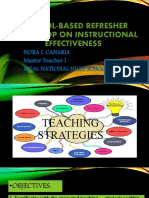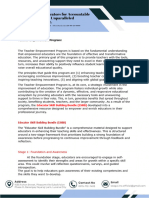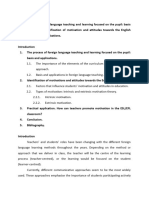0 ratings0% found this document useful (0 votes)
162 viewsTeaching by Jere Brophy
Teaching by Jere Brophy
Uploaded by
api-350475725- The document outlines 12 principles of effective teaching that emerged from research: establishing a supportive classroom climate, providing opportunities to learn, aligning curriculum, establishing learning orientations, coherent content, thoughtful discourse, practice and application activities, scaffolding students' task engagement, strategy teaching, cooperative learning, goal-oriented assessment, and establishing appropriate achievement expectations. The principles emphasize creating a caring learning environment, aligning all aspects of teaching to learning goals, and providing supports and feedback to help students master content.
Copyright:
© All Rights Reserved
Available Formats
Download as DOCX, PDF, TXT or read online from Scribd
Teaching by Jere Brophy
Teaching by Jere Brophy
Uploaded by
api-3504757250 ratings0% found this document useful (0 votes)
162 views3 pages- The document outlines 12 principles of effective teaching that emerged from research: establishing a supportive classroom climate, providing opportunities to learn, aligning curriculum, establishing learning orientations, coherent content, thoughtful discourse, practice and application activities, scaffolding students' task engagement, strategy teaching, cooperative learning, goal-oriented assessment, and establishing appropriate achievement expectations. The principles emphasize creating a caring learning environment, aligning all aspects of teaching to learning goals, and providing supports and feedback to help students master content.
Original Title
teaching by jere brophy
Copyright
© © All Rights Reserved
Available Formats
DOCX, PDF, TXT or read online from Scribd
Share this document
Did you find this document useful?
Is this content inappropriate?
- The document outlines 12 principles of effective teaching that emerged from research: establishing a supportive classroom climate, providing opportunities to learn, aligning curriculum, establishing learning orientations, coherent content, thoughtful discourse, practice and application activities, scaffolding students' task engagement, strategy teaching, cooperative learning, goal-oriented assessment, and establishing appropriate achievement expectations. The principles emphasize creating a caring learning environment, aligning all aspects of teaching to learning goals, and providing supports and feedback to help students master content.
Copyright:
© All Rights Reserved
Available Formats
Download as DOCX, PDF, TXT or read online from Scribd
Download as docx, pdf, or txt
0 ratings0% found this document useful (0 votes)
162 views3 pagesTeaching by Jere Brophy
Teaching by Jere Brophy
Uploaded by
api-350475725- The document outlines 12 principles of effective teaching that emerged from research: establishing a supportive classroom climate, providing opportunities to learn, aligning curriculum, establishing learning orientations, coherent content, thoughtful discourse, practice and application activities, scaffolding students' task engagement, strategy teaching, cooperative learning, goal-oriented assessment, and establishing appropriate achievement expectations. The principles emphasize creating a caring learning environment, aligning all aspects of teaching to learning goals, and providing supports and feedback to help students master content.
Copyright:
© All Rights Reserved
Available Formats
Download as DOCX, PDF, TXT or read online from Scribd
Download as docx, pdf, or txt
You are on page 1of 3
Notes for:
goals of the instruction, not by miscellaneous content coverage
Teaching by Jere Brophy pressures or test items.
- This is about a set of principles of effective teaching that have - A curriculum is not an end in itself; it is a means of helping
emerged from research in classrooms. It talks of curriculum, students to learn what is considered essential for preparing them to
instruction and assessment, as well as classroom organization and fulfil adult roles in society and realize their potential as
management practices that support effective instruction. individuals.
1. A Supportive Classroom Climate 4. Establishing Learning Orientations
- Students learn best within cohesive and caring communities. - Teachers can prepare students for learning by providing an initial
- Students optimizes their learning opportunities if they can structure to clarify intended outcomes and cue desired learning
participate and support to the leaning community that they are in. strategies.
- What a teacher should be: a cheerful disposition, friendliness, - The beginning of the class should contain the following:
emotional maturity, sincerity, and caring about students as communicating the purpose of the learning, connecting it to prior
individuals as well as learners. knowledge, cueing the kinds of student responses that the activity
- Teachers should provide an environment where they treat requires, and stimulate students motivation.
mistakes as natural parts of the learning process and where they - Other ways to help students learn with a sense of purpose and
are encouraged to work collaboratively and help one another. direction include calling attention to the activitys goals,
overviewing main ideas or major steps to be elaborated, pre - tests
2. Opportunity to Learn that sensitize students to main points to learn, and pre - questions
- Students learn more when most of the available time is allocated that stimulate their thinking about the topic.
to curriculum-related activities and the classroom management
system emphasizes maintaining their engagement in those 5. Coherent Content
activities. - To facilitate meaningful learning and retention, content is
- Effective teachers allocate most of the available time to explained clearly and developed with emphasis on its structure and
activities designed to accomplish instructional goals. connections.
- teachers who approach management as a process of establishing - networks of connected knowledge structured around powerful
an effective learning environment tend to be more successful than ideas can be learned with understanding and retained in forms that
teachers who emphasize their roles as disciplinarians. make them accessible for application.
- Opportunity to learn is sometimes defined as the degree of - Whether in textbooks or in teacher-led instruction, information
overlap between what is taught and what is tested. is easier to learn to the extent that it is coherentthe sequence of
ideas or events makes sense and the relationships among them are
3. Curricular Alignment apparent.
- All components of the curriculum are aligned to create a cohesive - In order to effectively do it teachers need to:
programme for accomplishing instructional purposes and goals. (i) retreat from breadth of coverage - most important content in
- Teaching should be a goal-oriented curriculum development, in greater depth;
which curricular planning is guided by the overall purposes and (ii) represent this important content as networks of connected
Notes for:
information structured around powerful ideas; them to engage in learning activities productively.
(iii) develop the content with a focus on explaining these important - Assignment is one way.
ideas and the connections among them; and - Activities that will strengthen the gained knowledge or skill.
(iv) follow up with authentic learning activities and assessment - The teacher should provide assistance if needed like answering
measures that provide students with opportunities to develop and inquiries about the assignment or activities or having a re-teaching
display learning that reflects the intended outcomes of the or tutoring sessions of needed.
instruction.
9. Strategy Teaching
6. Thoughtful Discourse - The teacher models and instructs students in learning and self-
- Questions are planned to engage students in sustained discourse regulation strategies.
structured around powerful ideas. - This requires comprehensive instruction that includes attention to
- They use questions to stimulate students to process and reflect propositional knowledge (what to do), procedural knowledge
on content, recognize relationships among and implications of its (how to do it) and conditional knowledge (when and why to do
key ideas, think critically about it, and use it in problem solving, it).
decision making or other higher-order applications. - A teacher can model and instruct through rehearsal, elaboration,
- The questions should be addressed to the class as a whole. organization, comprehension monitoring, and affect monitoring.
- Teacher should ask them to explain and elaborate their answers.
10. Co-operative Learning
7. Practice and Application Activities - Students often benefit from working in pairs or small groups to
- Students need sufficient opportunities to practise and apply what construct understandings or help one another master skills.
they are learning, and to receive improvement-oriented feedback. - Co-operative learning promotes affective and social benefits
- Three main ways in which teachers help their students to learn. such as increased student interest in and valuing of subject matter,
First, they present information, explain concepts and model skills. and increases in positive attitudes and social interactions among
Second, they ask questions and lead their students in discussion students who differ in gender, race, ethnicity, achievement levels
and other forms of discourse surrounding the content. and other characteristics.
Third, they engage students in activities or assignments that - Co-operative learning methods are most likely to enhance
provide them with opportunities to practise or apply what they are learning outcomes if they combine group goals with individual
learning. accountability.
- Practice is one of the most important yet least appreciated aspects
of learning in classrooms. 11. Goal-Oriented Assessment
- Practice must involve opportunities not only to apply skills but - The teacher uses a variety of formal and informal assessment
also to receive timely feedback which are informative rather than methods to monitor progress towards learning goals.
evaluative. - Effective teachers routinely monitor their students progress using
both formal tests or performance evaluations and informal
8. Scaffolding Studentstask Engagement assessments of students contributions to lessons and work on
- The teacher provides whatever assistance students need to enable assignments.
Notes for:
- Effective teachers use assessment for evaluating students 12. Achievement Expectations
progress in learning and for planning curriculum improvements, - The teacher establishes and follows through on appropriate
not just for generating grades. expectations for learning outcomes.
- In general, assessment should be treated as an ongoing and - Teachers should form and project expectations that are as
integral part of each instructional unit. positive as they can be while still remaining realistic.
- Teachers should expect all their students to progress sufficiently
to enable them to perform satisfactorily at the next level.
You might also like
- Ubd Chapter 5 - Essential Questions 1Document5 pagesUbd Chapter 5 - Essential Questions 1api-651337707No ratings yet
- Brophy 1Document3 pagesBrophy 1api-350784455No ratings yet
- 12 Teaching Strategies by Jere Brophy PDFDocument2 pages12 Teaching Strategies by Jere Brophy PDFScribdTranslationsNo ratings yet
- ApproachesDocument8 pagesApproaches21-2338-eNo ratings yet
- Profed4Document47 pagesProfed4Rommel Taliping Mabborang100% (1)
- BrophyDocument3 pagesBrophyapi-350607363No ratings yet
- Notes From BrophyDocument4 pagesNotes From Brophyapi-350490799No ratings yet
- Michael Fullan, PeterDocument17 pagesMichael Fullan, PeterReynaldo RebodosNo ratings yet
- Module - Gonzales - Facilitating Learning - 2Document4 pagesModule - Gonzales - Facilitating Learning - 2ariannerose gonzalesNo ratings yet
- Principles of TeachingDocument149 pagesPrinciples of TeachingJane EmjhayNo ratings yet
- Project Based LearningDocument5 pagesProject Based LearningSusmita PathakNo ratings yet
- Principles of TeachingDocument141 pagesPrinciples of TeachingfrizamyrtongcoNo ratings yet
- Learner-Centered Pyschological Principles HandoutDocument5 pagesLearner-Centered Pyschological Principles HandoutvincelawrenceempenoNo ratings yet
- Delivery Modes and Instructional ApproachesDocument4 pagesDelivery Modes and Instructional ApproachesAnn Jelica MonterolaNo ratings yet
- Module 1: Effective Teaching: I-ObjectivesDocument6 pagesModule 1: Effective Teaching: I-ObjectivesGraciella MabalingNo ratings yet
- CHPTR 3 PSTMLS Principles of TeachingDocument2 pagesCHPTR 3 PSTMLS Principles of TeachingBea Reen BurgosNo ratings yet
- PCK 1 Module 2 Week 3 LCPDocument28 pagesPCK 1 Module 2 Week 3 LCPCharlene Mae de leonNo ratings yet
- Authentic Assessment NotesDocument4 pagesAuthentic Assessment NotesJoyNo ratings yet
- Pangasinan State University: School of Advanced Studies Urdaneta City, Pangasinan 2 Semester, Academic Year 2021-2022Document4 pagesPangasinan State University: School of Advanced Studies Urdaneta City, Pangasinan 2 Semester, Academic Year 2021-2022avy mariel alcantaraNo ratings yet
- Typesofcurriculumdesign1 171223192318Document25 pagesTypesofcurriculumdesign1 171223192318riyan adistiNo ratings yet
- Edu 2 Chapter 7Document37 pagesEdu 2 Chapter 7Shane LouiseNo ratings yet
- Lesson 5: Curriculum Development: Processes and ModelsDocument11 pagesLesson 5: Curriculum Development: Processes and ModelsAngel Keith GicaNo ratings yet
- P Based LearningDocument8 pagesP Based LearningPdianghunNo ratings yet
- Unit 3 TeachersDocument5 pagesUnit 3 TeachersbalajoberrylkateNo ratings yet
- Outlines and Notes - WeeblyDocument6 pagesOutlines and Notes - Weeblyapi-348909996No ratings yet
- Principles of Teaching 1 (2nd Copy)Document142 pagesPrinciples of Teaching 1 (2nd Copy)DENOMINATORNo ratings yet
- Refresher On Instructional StrategiesDocument28 pagesRefresher On Instructional StrategiesBong Imperio100% (1)
- Principles of TeachingDocument142 pagesPrinciples of Teachingf10691122No ratings yet
- Esbb2 Seagul 2023Document15 pagesEsbb2 Seagul 2023RODEL AZARESNo ratings yet
- MtalDocument15 pagesMtalMaria Leonora FuerteNo ratings yet
- Instructional PlanningDocument7 pagesInstructional PlanningErica JambonganaNo ratings yet
- Unit 1 Genral Method of TeachingDocument61 pagesUnit 1 Genral Method of TeachingSadam IrshadNo ratings yet
- Principles of Teaching ReviewerDocument3 pagesPrinciples of Teaching ReviewerKaitlyn Rayter100% (1)
- Nature Approaches and Designs in Curriculum Development Annie v. AreDocument52 pagesNature Approaches and Designs in Curriculum Development Annie v. AreitsmemaryposaNo ratings yet
- Curriculum ExpDocument3 pagesCurriculum ExpKim Nicole VargasNo ratings yet
- Approaches To Curriculum Design 2Document47 pagesApproaches To Curriculum Design 2PreciousMaviSalemCarcosiaNo ratings yet
- Lesson-1-Principles-of-Teaching 3Document6 pagesLesson-1-Principles-of-Teaching 31701791No ratings yet
- Module-1 Learner-Centered Psychological PrinciplesDocument11 pagesModule-1 Learner-Centered Psychological PrinciplesriegocessyNo ratings yet
- 8601 Assigment No1Document30 pages8601 Assigment No1sidroghani4848No ratings yet
- Week 6 NotesDocument5 pagesWeek 6 NotesReyna CarenioNo ratings yet
- Introduction 14 Principles Metacognition by Jiahalim K. TumogDocument48 pagesIntroduction 14 Principles Metacognition by Jiahalim K. Tumoggrace roma khanNo ratings yet
- Educ 9Document2 pagesEduc 9jaeledeneve.1999No ratings yet
- Topic 25. EFLDocument13 pagesTopic 25. EFLAntonioNo ratings yet
- PSTMLS MidtermsDocument16 pagesPSTMLS MidtermsJohn Oliver AsiaNo ratings yet
- Principles and Methods in TeachingDocument108 pagesPrinciples and Methods in TeachingMOHAMMAD DATUGANNo ratings yet
- Curriculum Design and Development - An OverviewDocument16 pagesCurriculum Design and Development - An OverviewAimable InezaNo ratings yet
- Teaching Multi-Grade Classes: Topic 16. Direct and Indirect Strategy Direct InstructionDocument2 pagesTeaching Multi-Grade Classes: Topic 16. Direct and Indirect Strategy Direct InstructionMaricel ViloriaNo ratings yet
- Educ 103 NotesDocument20 pagesEduc 103 NotesSOFHIA CLAIRE SUMBAQUILNo ratings yet
- Activity 4: Writing My First Lesson Plan: Here Starts The Lesson!Document31 pagesActivity 4: Writing My First Lesson Plan: Here Starts The Lesson!AngelaNo ratings yet
- Competency-Based Education and Outcome-Based EducationDocument29 pagesCompetency-Based Education and Outcome-Based EducationCillo Mariel100% (4)
- Module 2 Lesson 1 2 3 SocStEd 311Document41 pagesModule 2 Lesson 1 2 3 SocStEd 311Miguel Maribao Aquino Jr.No ratings yet
- Unit Plan: IntroductionDocument4 pagesUnit Plan: Introductionsuman guptaNo ratings yet
- Educ 2 ADocument144 pagesEduc 2 ADhon ValeNo ratings yet
- Instructional Strategies:-: IntroductionDocument10 pagesInstructional Strategies:-: IntroductionSnehaNo ratings yet
- Code 8601Document12 pagesCode 8601عائشہ حسینNo ratings yet
- Annex C2 - PPT-Facilitate The Teaching-Learning ProcessDocument16 pagesAnnex C2 - PPT-Facilitate The Teaching-Learning ProcessLeu Gim Habana Panugan100% (1)
- (Template) Prof Ed 7 - Ch1Lesson 1Document7 pages(Template) Prof Ed 7 - Ch1Lesson 1jennymacion20No ratings yet
- Principles OF TeachingDocument142 pagesPrinciples OF TeachingEimerej C. SpiritNo ratings yet
- Learning & Study Guide for Adult Students: Teacher's ManualFrom EverandLearning & Study Guide for Adult Students: Teacher's ManualNo ratings yet
- Professional Skills and Abilities of Effective TeachersDocument3 pagesProfessional Skills and Abilities of Effective Teachersapi-350475725No ratings yet
- Notes For Steppingstones Chapter 1 Setting Out On The Curriculum PathDocument2 pagesNotes For Steppingstones Chapter 1 Setting Out On The Curriculum Pathapi-350475725No ratings yet
- Acts of Teaching Chapter 14 Reflective Skills of Effective TeachersDocument1 pageActs of Teaching Chapter 14 Reflective Skills of Effective Teachersapi-350475725No ratings yet
- Acts of Teaching Chapter 7 Four Instructional AlternativesDocument6 pagesActs of Teaching Chapter 7 Four Instructional Alternativesapi-350475725No ratings yet
- Acts of Teaching Chapter 6Document3 pagesActs of Teaching Chapter 6api-350475725No ratings yet
- Cambridge Reading Adventures Wellbeing Brochure - tcm142-696504Document22 pagesCambridge Reading Adventures Wellbeing Brochure - tcm142-696504w.enninfulNo ratings yet
- Handa 102605 Ppce Aut 2021 ReportDocument1 pageHanda 102605 Ppce Aut 2021 Reportapi-554345821No ratings yet
- The 21 Century, The Competency Era and Competency TheoryDocument12 pagesThe 21 Century, The Competency Era and Competency TheoryGerald Curtan ElloNo ratings yet
- Translation Now and ThenDocument3 pagesTranslation Now and ThenMaria DobromirNo ratings yet
- Republic of The PhilippinesDocument9 pagesRepublic of The PhilippinesAnit Eiram OcramNo ratings yet
- The Importance of Management Development in An Organizational SystemDocument9 pagesThe Importance of Management Development in An Organizational SystemGangadharNo ratings yet
- My Dissertation's Research ProposalDocument24 pagesMy Dissertation's Research ProposalMomha BiumlaNo ratings yet
- Peer MediationDocument9 pagesPeer Mediationapi-485997026No ratings yet
- Group Activity:: Performance Task 3 Instruction: Answer The Following QuestionsDocument4 pagesGroup Activity:: Performance Task 3 Instruction: Answer The Following QuestionsDiana CortezNo ratings yet
- 8 Designing Open-Ended Text-Based QuestionsDocument3 pages8 Designing Open-Ended Text-Based Questionsapi-234300004No ratings yet
- Rubric Made Using: RubiStar (Http://Rubistar.4teachers - Org)Document2 pagesRubric Made Using: RubiStar (Http://Rubistar.4teachers - Org)mrs_haynesNo ratings yet
- Foster Independence With Minimal PromptsDocument1 pageFoster Independence With Minimal Promptsapi-310403107No ratings yet
- Table of Education VocabularyDocument2 pagesTable of Education VocabularyVlad VargauNo ratings yet
- HeilmanWelle FORMAL AND INFORMAL DISCRIMINATION AGAINSTDocument18 pagesHeilmanWelle FORMAL AND INFORMAL DISCRIMINATION AGAINSTInês VieiraNo ratings yet
- Motor Development Lab 4Document5 pagesMotor Development Lab 4api-244843774No ratings yet
- Evidence Identities SenaDocument5 pagesEvidence Identities SenaMiguelAngelCoralNo ratings yet
- Different Theories of Confidence With SourcesDocument79 pagesDifferent Theories of Confidence With SourcesRussiel Dagohoy100% (1)
- Css SyllabusDocument3 pagesCss SyllabusAnonymous cRMw8feac8No ratings yet
- SSC Stenographer Syllabus PDF 84Document7 pagesSSC Stenographer Syllabus PDF 84akshay prajapatiNo ratings yet
- Rhyming PoemsDocument5 pagesRhyming Poemsapi-364966158No ratings yet
- Cookery 10 Lesson Plan - DemoDocument5 pagesCookery 10 Lesson Plan - DemoChema Paciones100% (2)
- Art Fundamentals SyllabusDocument4 pagesArt Fundamentals Syllabusapi-496209170No ratings yet
- DM COE Leader - Job Description - 200912Document1 pageDM COE Leader - Job Description - 200912manishkdwivediNo ratings yet
- English Grade 12 Note 1Document6 pagesEnglish Grade 12 Note 1Kaleab AlebachewNo ratings yet
- Research Survey QuestionnaireDocument3 pagesResearch Survey QuestionnaireReshane SoberanoNo ratings yet
- Signature AssignmentDocument6 pagesSignature Assignmentapi-326311545No ratings yet
- A Pathway To Equitable Math Instruction IdentityDocument25 pagesA Pathway To Equitable Math Instruction IdentityThePoliticalHatNo ratings yet
- Beauty Cosmetics: Preference of Home Economics Senior High School Students at San Miguel National High SchoolDocument16 pagesBeauty Cosmetics: Preference of Home Economics Senior High School Students at San Miguel National High SchoolJoyce Micaela SuingNo ratings yet
- Syllabus PsycholinguisticsDocument3 pagesSyllabus Psycholinguisticsyudi909No ratings yet






























































































